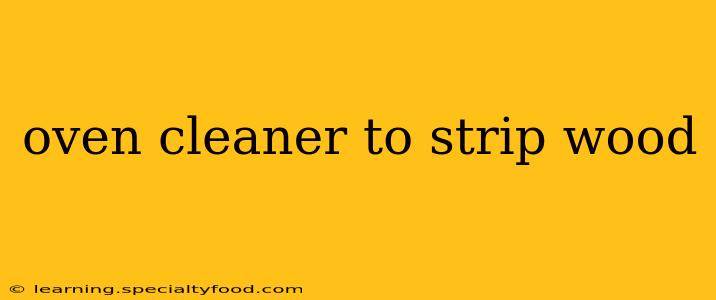Oven cleaner is a powerful chemical designed to dissolve baked-on grease and grime. While some DIY enthusiasts have explored using it to strip paint and varnish from wood, it's a risky and potentially dangerous method that should be approached with extreme caution—if at all. This article will explore the potential benefits, significant drawbacks, and safer alternatives to using oven cleaner for wood stripping.
Does Oven Cleaner Actually Strip Wood?
Yes, the strong alkaline nature of most oven cleaners can chemically break down layers of paint, varnish, or lacquer on wood. The caustic chemicals effectively dissolve the coatings, making them easier to scrape off. However, this process is far from precise, and the aggressive chemicals pose substantial risks.
What are the Risks of Using Oven Cleaner on Wood?
This is where the significant drawbacks come into play. The risks associated with using oven cleaner on wood far outweigh any perceived benefits. Here are some key concerns:
- Damage to the Wood: Oven cleaner's harsh chemicals can damage the underlying wood itself, causing discoloration, etching, or even weakening the structure. This is particularly true for softer wood species.
- Chemical Burns: The fumes are extremely irritating to the eyes, nose, and lungs. Skin contact can cause severe chemical burns. Always wear appropriate safety gear, including gloves, eye protection, and a respirator. Even with proper safety precautions, accidents can happen.
- Environmental Impact: Oven cleaners contain volatile organic compounds (VOCs) that are harmful to the environment. Proper disposal is crucial, and improper handling can lead to environmental contamination.
- Unpredictable Results: The stripping process is highly unpredictable. You may not achieve even removal, resulting in an uneven surface requiring significant sanding or further treatment.
- Health Hazards: Long-term exposure to the fumes can cause serious health problems.
What are Safer Alternatives to Oven Cleaner for Stripping Wood?
There are many safer and more effective methods available for stripping paint and varnish from wood. These methods minimize the risks associated with harsh chemicals and offer more predictable results:
- Chemical Strippers: Specifically formulated wood strippers are available at most hardware stores. These are designed to break down paint and varnish without causing significant damage to the wood. Always follow the manufacturer's instructions carefully and use appropriate safety gear.
- Heat Gun: A heat gun can soften paint and varnish, making it easier to scrape off. This method requires patience and precision, but it's generally safer than using oven cleaner. Be careful not to overheat the wood.
- Sanding: For thin layers of paint or varnish, sanding can be an effective method. Start with coarser grit sandpaper and gradually move to finer grits to achieve a smooth finish. This method is labor-intensive but environmentally friendly.
How Do I Dispose of Oven Cleaner Safely?
Never pour oven cleaner down the drain or into the trash. Follow the manufacturer's instructions carefully regarding disposal. This usually involves contacting your local waste management authority for guidance on proper disposal of hazardous chemicals.
Is it worth the risk?
In short, no. The potential damage to the wood, the significant health risks, and the unpredictable results make using oven cleaner to strip wood a highly discouraged practice. The safer and more effective alternatives readily available make this a method best avoided. Prioritize your safety and the longevity of your wood project by opting for safer stripping techniques.
